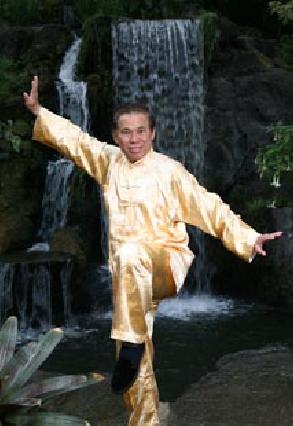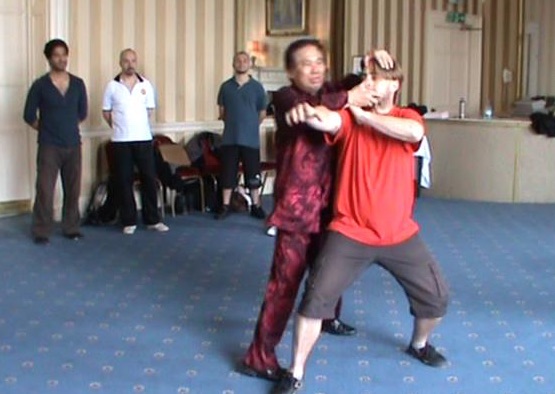ART OF HEI SAI, OR SPIRIT OF ENERGY

The spirit of the crane is noticeable in this pattern
Question
The list of 72 Arts of Shaolin practiced in Shaolin Wahnam makes for quite extraordinarily reading. Thank you for very much for kindly posting it.
My question relates to one of the arts listed: The Art of Hei Sai (energy spirit). What is the relationship between the Art of Hei Sai and Shen training?
How has the Art of Hei Sai evolved in the very long history of Shaolin in terms of methods of training the art, and the attainment of, and benefits to practitioners of the art?
Sifu Kevin Barry, Ireland
Answer
I am glad you have found the list of 72 Arts of Shaolin practiced in Shaolin Wahnam extraordinary reading. It is a good reference to what we teach in our school, as well as for students and instructors to review.
It is a loose list, i.e. the 72 arts are chosen quite arbitrarily and some arts take a relatively short time to accomplish compared to other arts. It also reflects that the lists in other sources were arbitrarily chosen, and different sources may provide different lists.
"Hei Sai" is in Cantonese Chinese. In Mandarin, although the written words are the same, the pronouncement is “qi shi”. “Qi” means “energy”, as in qigong. “Shi” means “technique” or “form”, as in “zhao shi”. Literally the two words means “energy technique”. But I have translated “hei sai” or “qi shi” as “energy spirit”, which is closer to what is meant by the term. A practitioner performs a technique in such a way that the spirit of the technique is manifested as vibrant energy.
Some students attending a course with me, sometimes heard me saying, “Don’t do opium smoking,” when a student performed a pattern listlessly. He should perform the pattern with “hai sai”, or at least perform it as a kungfu pattern with good form, some force and vitality.
Many Shaolin patterns can be manifested in Shaolin animals. For example, “Traveling Dragon Plays with Water” takes the form of a dragon, and “Black Tiger Steals Heart” takes the form of a tiger. When performing these patterns, practitioners should manifest the spirit of the patterns. Hence, when performing “Traveling Dragon Plays with Water”, they should manifest the spirit of a dragon, and when performing “Black Tiger Steals Heart”, they should manifest the spirit of the tiger. They should have “hei sai”. If they perform the patterns like a worm or a cat, they are “doing opium smoking”.
Some Shaolin patterns may not take the form of Shaolin animals, like “Second Brother Offers Wine” in Tantui, and “Lohan Strikes Drum” in Eighteen Lohan Fist. This does not mean they have no "hei sai". Practitioners should perform them with good form, force and vitality, which demonstrates their spirit. If practitioners perform the pattern listlessly, they “do opium smoking”. It is the same with all other styles of kungfu, and in fact with all other styles of martial arts.
Shen training, or mind training, is a set, and "hei sai" or "energy spirit", is a sub-set. In other words, “hei sai” is part of mind training. There are other methods of mind training, like meditation, set practice and combat application. When we perform a set, for example, we must have presence of mind. If the prescence of mind is outstanding, we have "hei sai".
There is no record of “hei sai” in the long history of Shaolin or any other kungfu styles. As in life, some people perform their tasks listlessly, some ordinarily, and a few with gusto. Those who perform their kungfu movements with gusto have “hei sai”.
I was lucky. All my four sifu had “hei sai” when perfroming their kungfu. They exhibited excellent examples for me to follow.
I was not sure whether my sifus made any special effort to have "hei sai". But I believed their performance of kungfu with "hei sai" was habitual, without any conscious effort. Indeed, the term "hei sai" was not often mentioned in the schools I learned from. This means that my sifu did not specially teach "hei sai".
How would you develop "hei sai". Very simple. Perform each pattern – individually, in a set, in a sequence, or in combat – with picture-perfect form, energy flow which gives force and speed, and presence of mind. You may have to put in effort initially, but gradually it becomes habitual. Eventually, not only you have "hei sai" in your kungfu performance, but also in daily life.
With the attainment of "hei sai", the benefits are tremendous. You may recall my statement to make every movement a masterpiece, not just in kungfu but also in daily life. It means that no matter what you do, you will get the best results. Just imagine: no matter what you do, you will get the best result when you have "hei sai", i.e. when you perform every task with picture-perfect form, energy flow and presence of mind. This is, I believe, an unprecedented benefit of training our arts.

"Hei sai" or spirit of energy is not only in solo patterns but also in combat application
This question and answer are reproduced from the thread 10 Questions on the 72 Shaolin Arts in the Shaolin Wahnam Discussion Forum.
LINKS
